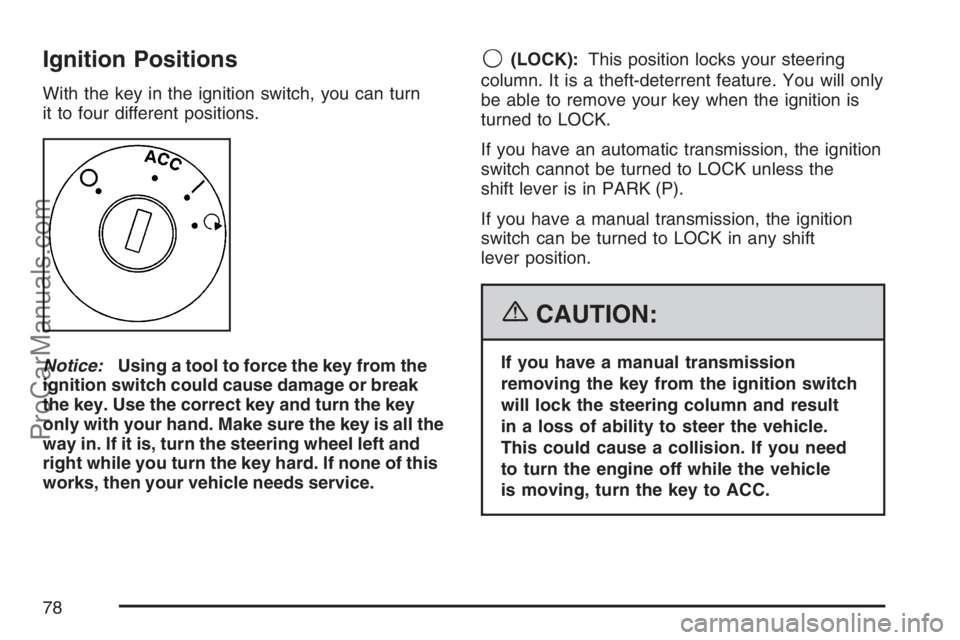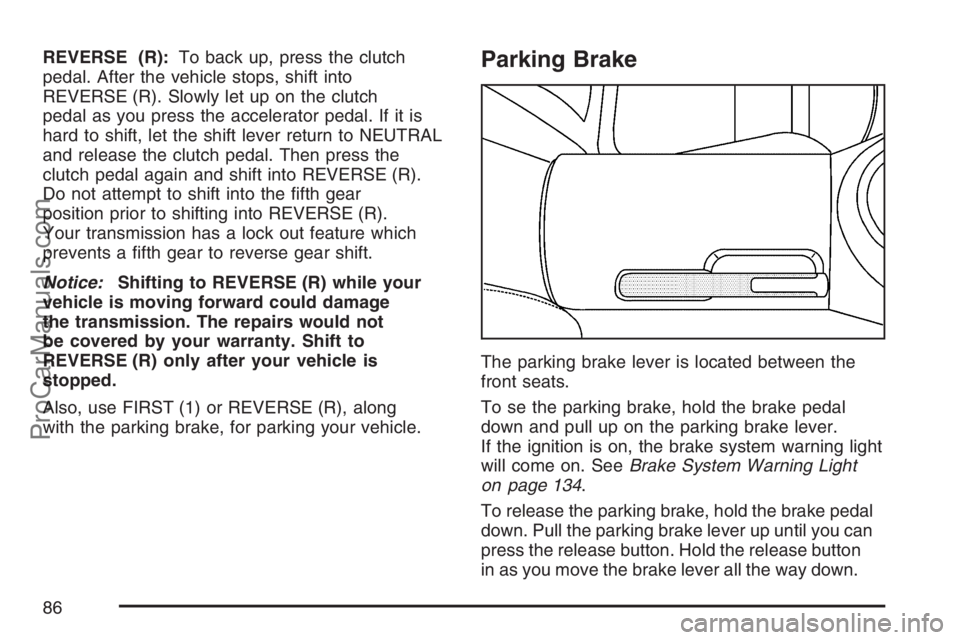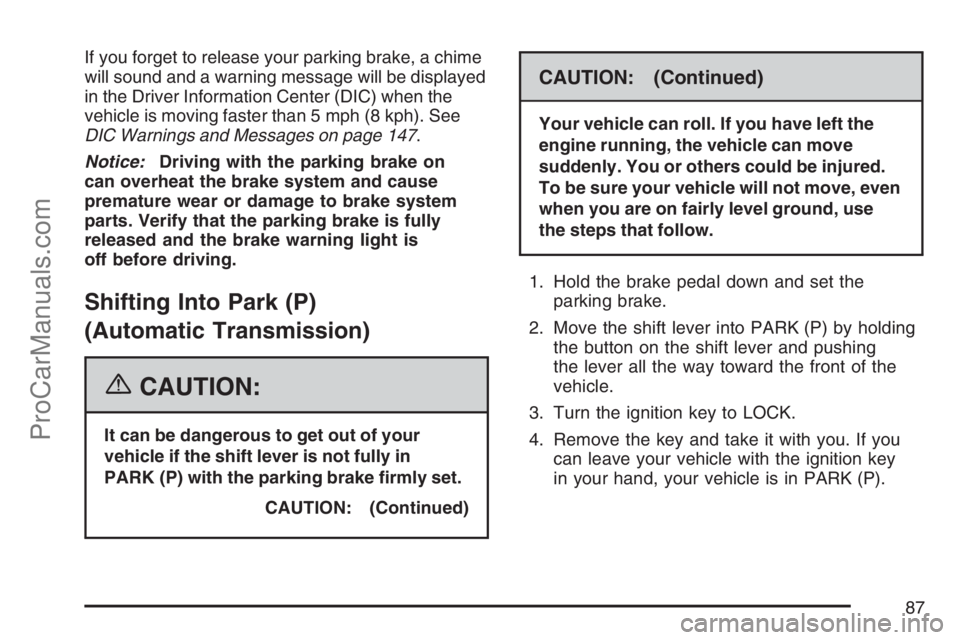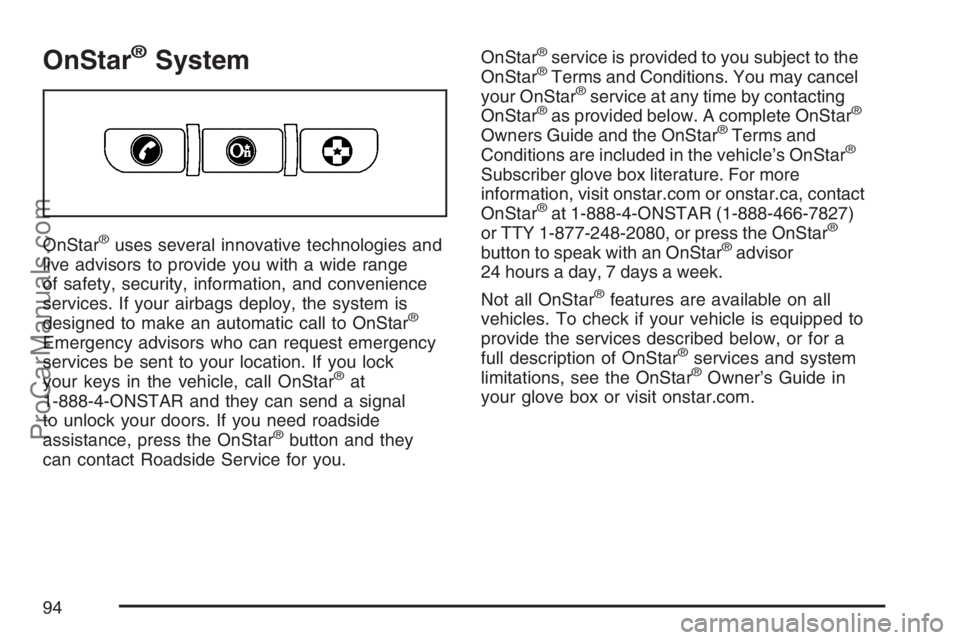lock SATURN SKY 2007 Owner's Manual
[x] Cancel search | Manufacturer: SATURN, Model Year: 2007, Model line: SKY, Model: SATURN SKY 2007Pages: 384, PDF Size: 2.47 MB
Page 78 of 384

Ignition Positions
With the key in the ignition switch, you can turn
it to four different positions.
Notice:Using a tool to force the key from the
ignition switch could cause damage or break
the key. Use the correct key and turn the key
only with your hand. Make sure the key is all the
way in. If it is, turn the steering wheel left and
right while you turn the key hard. If none of this
works, then your vehicle needs service.
9(LOCK):This position locks your steering
column. It is a theft-deterrent feature. You will only
be able to remove your key when the ignition is
turned to LOCK.
If you have an automatic transmission, the ignition
switch cannot be turned to LOCK unless the
shift lever is in PARK (P).
If you have a manual transmission, the ignition
switch can be turned to LOCK in any shift
lever position.
{CAUTION:
If you have a manual transmission
removing the key from the ignition switch
will lock the steering column and result
in a loss of ability to steer the vehicle.
This could cause a collision. If you need
to turn the engine off while the vehicle
is moving, turn the key to ACC.
78
ProCarManuals.com
Page 79 of 384

ACC (ACCESSORY):This position operates
some of your electrical accessories. It unlocks the
steering wheel and ignition.
R(RUN):This is the position the switch returns
to after you start your engine and release the
switch. The switch stays in RUN when the engine
is running. But even when the engine is not
running, you can use RUN to operate your
electrical accessories and to display some warning
and indicator lights.
The battery could be drained if you leave the key
in the ACC or RUN position with the engine
off. You may not be able to start your vehicle if
the battery is allowed to drain for an extended
period of time.
/(START):This position starts the engine.
When the engine starts, release the key.
The ignition switch will return to RUN for normal
driving.
A warning tone will sound if you open the driver’s
door while in LOCK or ACC, when the key has
not been removed from the ignition.
Key In the Ignition
Never leave your vehicle with the keys inside,
as it is an easy target for joy riders or thieves.
If you leave the key in the ignition and park your
vehicle, a chime will sound, when you open
the driver’s door. Always remember to remove
your key from the ignition and take it with you.
This will lock your ignition and transaxle.
Also, always remember to lock the doors.
The battery could be drained if you leave the key
in the ignition while your vehicle is parked. You may
not be able to start your vehicle after it has been
parked for an extended period of time.
Retained Accessory Power (RAP)
Your vehicle has a Retained Accessory
Power (RAP) feature which will allow the radio
and power windows to continue to work up
to 10 minutes after the ignition is turned off.
Your vehicle’s radio will work when the ignition
key is in RUN or ACC. Once the key is turned off,
the radio and power windows will continue to
work for up to 10 minutes or until any door
is opened.
79
ProCarManuals.com
Page 81 of 384

To prevent gear damage, this system also
prevents cranking if the engine is already
running. Engine cranking can be stopped by
turning the ignition switch to ACC or LOCK.
Notice:Cranking the engine for long periods
of time, by returning the key to the START
position immediately after cranking has ended,
can overheat and damage the cranking
motor, and drain the battery. Wait at least
15 seconds between each try, to allow
the cranking motor to cool down.
2. If the engine does not start after 5-10 seconds,
especially in very cold weather (below 0°F
or−18°C), it could be �ooded with too much
gasoline. Try pushing the accelerator
pedal all the way to the �oor and holding it
there as you hold the key in START for up to
a maximum of 15 seconds. Wait at least
15 seconds between each try, to allow the
cranking motor to cool down. When the engine
starts, let go of the key and accelerator.If the vehicle starts brie�y but then stops
again, do the same thing. This clears the extra
gasoline from the engine. Do not race the
engine immediately after starting it. Operate
the engine and transmission gently until the oil
warms up and lubricates all moving parts.
Notice:Your engine is designed to work with
the electronics in your vehicle. If you add
electrical parts or accessories, you could
change the way the engine operates. Before
adding electrical equipment, check with
your retailer. If you do not, your engine might
not perform properly. Any resulting damage
would not be covered by your vehicle’s
warranty.
81
ProCarManuals.com
Page 82 of 384

Automatic Transmission Operation
If your vehicle has an automatic transmission,
the shift lever is located on the center console
between the front seats.
There are several
different positions for
the shift lever.
PARK (P):This position locks the rear wheels.
It is the best position to use when you start the
engine because your vehicle cannot move easily.{CAUTION:
It can be dangerous to get out of your
vehicle if the shift lever is not fully in
PARK (P) with the parking brake �rmly
set. Your vehicle can roll. If you have left
the engine running, the vehicle can move
suddenly. You or others could be injured.
To be sure your vehicle will not move,
even when you are on fairly level ground,
use the steps that follow.
Make sure the shift lever is fully in PARK (P)
before starting the engine. Your vehicle has an
automatic transmission shift lock control system.
You must fully apply your regular brakes �rst
and then press the shift lever button before you
can shift from PARK (P) when the ignition key is
in RUN. If you cannot shift out of PARK (P),
ease pressure on the shift lever and push the
shift lever all the way into PARK (P) as you
maintain brake application. Then press the shift
lever button and move the shift lever into another
gear. SeeShifting Out of Park (P) on page 89.
82
ProCarManuals.com
Page 86 of 384

REVERSE (R):To back up, press the clutch
pedal. After the vehicle stops, shift into
REVERSE (R). Slowly let up on the clutch
pedal as you press the accelerator pedal. If it is
hard to shift, let the shift lever return to NEUTRAL
and release the clutch pedal. Then press the
clutch pedal again and shift into REVERSE (R).
Do not attempt to shift into the �fth gear
position prior to shifting into REVERSE (R).
Your transmission has a lock out feature which
prevents a �fth gear to reverse gear shift.
Notice:Shifting to REVERSE (R) while your
vehicle is moving forward could damage
the transmission. The repairs would not
be covered by your warranty. Shift to
REVERSE (R) only after your vehicle is
stopped.
Also, use FIRST (1) or REVERSE (R), along
with the parking brake, for parking your vehicle.Parking Brake
The parking brake lever is located between the
front seats.
To se the parking brake, hold the brake pedal
down and pull up on the parking brake lever.
If the ignition is on, the brake system warning light
will come on. SeeBrake System Warning Light
on page 134.
To release the parking brake, hold the brake pedal
down. Pull the parking brake lever up until you can
press the release button. Hold the release button
in as you move the brake lever all the way down.
86
ProCarManuals.com
Page 87 of 384

If you forget to release your parking brake, a chime
will sound and a warning message will be displayed
in the Driver Information Center (DIC) when the
vehicle is moving faster than 5 mph (8 kph). See
DIC Warnings and Messages on page 147.
Notice:Driving with the parking brake on
can overheat the brake system and cause
premature wear or damage to brake system
parts. Verify that the parking brake is fully
released and the brake warning light is
off before driving.
Shifting Into Park (P)
(Automatic Transmission)
{CAUTION:
It can be dangerous to get out of your
vehicle if the shift lever is not fully in
PARK (P) with the parking brake �rmly set.
CAUTION: (Continued)
CAUTION: (Continued)
Your vehicle can roll. If you have left the
engine running, the vehicle can move
suddenly. You or others could be injured.
To be sure your vehicle will not move, even
when you are on fairly level ground, use
the steps that follow.
1. Hold the brake pedal down and set the
parking brake.
2. Move the shift lever into PARK (P) by holding
the button on the shift lever and pushing
the lever all the way toward the front of the
vehicle.
3. Turn the ignition key to LOCK.
4. Remove the key and take it with you. If you
can leave your vehicle with the ignition key
in your hand, your vehicle is in PARK (P).
87
ProCarManuals.com
Page 88 of 384

Leaving Your Vehicle With the
Engine Running
{CAUTION:
It can be dangerous to leave your vehicle
with the engine running. Your vehicle
could move suddenly if the shift lever is
not fully in PARK (P) with the parking
brake �rmly set. And, if you leave the
vehicle with the engine running, it could
overheat and even catch �re. You or
others could be injured. Do not leave your
vehicle with the engine running.
If you have to leave your vehicle with the engine
running, be sure your vehicle is in PARK (P)
and your parking brake is �rmly set before you
leave it. After you have moved the shift lever into
PARK (P), hold the regular brake pedal down.If the vehicle has an automatic transmission, see if
you can move the shift lever away from PARK (P)
without �rst pushing the shift lock release button.
If you can, it means that the shift lever was not fully
locked into PARK (P).Torque Lock
If you are parking on a hill and you do not
shift your transmission into PARK (P) properly,
the weight of the vehicle may put too much
force on the parking pawl in the transmission.
You may �nd it difficult to pull the shift lever
out of PARK (P). This is called “torque lock.”
To prevent torque lock, set the parking brake
and then shift into PARK (P) properly before you
leave the driver’s seat. To �nd out how, see
Shifting Into Park (P) (Automatic Transmission)
on page 87.
88
ProCarManuals.com
Page 89 of 384

When you are ready to drive, move the shift
lever out of PARK (P)beforeyou release the
parking brake.
If torque lock does occur, you may need to
have another vehicle push yours a little uphill to
take some of the pressure from the parking pawl
in the transmission, so you can pull the shift
lever out of PARK (P).
Shifting Out of Park (P)
Your vehicle has an automatic transmission
shift lock control system.
To shift out of PARK (P):
1. Apply the regular brake pedal.
2. Then press the shift lever button.
3. Move the shift lever to the desired gear.If you are still unable to shift out of PARK (P):
1. Fully release the shift lever button.
2. While holding down the brake pedal,
press the shift lever button again.
3. Move the shift lever to the desired gear.
If you still cannot move the shift lever from
PARK (P), consult your dealer.
Parking Your Vehicle
(Manual Transmission)
Before leaving your manual transmission vehicle,
fully press the clutch pedal in, move the shift
lever in either FIRST (1) gear or REVERSE (R),
and �rmly apply the parking brake. SeeManual
Transmission Operation on page 85.
89
ProCarManuals.com
Page 94 of 384

OnStar®System
OnStar®uses several innovative technologies and
live advisors to provide you with a wide range
of safety, security, information, and convenience
services. If your airbags deploy, the system is
designed to make an automatic call to OnStar
®
Emergency advisors who can request emergency
services be sent to your location. If you lock
your keys in the vehicle, call OnStar
®at
1-888-4-ONSTAR and they can send a signal
to unlock your doors. If you need roadside
assistance, press the OnStar
®button and they
can contact Roadside Service for you.OnStar
®service is provided to you subject to the
OnStar®Terms and Conditions. You may cancel
your OnStar®service at any time by contacting
OnStar®as provided below. A complete OnStar®
Owners Guide and the OnStar®Terms and
Conditions are included in the vehicle’s OnStar®
Subscriber glove box literature. For more
information, visit onstar.com or onstar.ca, contact
OnStar
®at 1-888-4-ONSTAR (1-888-466-7827)
or TTY 1-877-248-2080, or press the OnStar®
button to speak with an OnStar®advisor
24 hours a day, 7 days a week.
Not all OnStar
®features are available on all
vehicles. To check if your vehicle is equipped to
provide the services described below, or for a
full description of OnStar
®services and system
limitations, see the OnStar®Owner’s Guide in
your glove box or visit onstar.com.
94
ProCarManuals.com
Page 95 of 384

OnStar®Services
For new vehicles with OnStar®, the Safe & Sound
Plan, or the Directions & Connections®Plan is
included for one year from the date of purchase.
You can extend this plan beyond the �rst year,
or upgrade to the Directions & Connections
®Plan.
For more information, press the OnStar®button
to speak with an advisor. Some OnStar®services
(such as Remote Door Unlock or Stolen Vehicle
Location Assistance) may not be available
until you register with OnStar
®.
Available Services with
Safe & Sound®Plan
Automatic Noti�cation of Airbag Deployment
Advanced Automatic Crash Noti�cation (AACN)
(If equipped)
Link to Emergency Services
Roadside Assistance
Stolen Vehicle Location Assistance
AccidentAssist
Remote Door Unlock/Vehicle Alert
OnStar®Vehicle Diagnostics
GM Goodwrench®On Demand Diagnostics
OnStar®Hands-Free Calling with
30 complimentary minutes
OnStar®Virtual Advisor ( U.S. Only)
Available Services included with
Directions & Connections®Plan
All Safe and Sound Plan Services
Driving Directions - Advisor delivered
or OnStar®Turn-by-Turn Navigation
(If equipped)
RideAssist
Information and Convenience Services
95
ProCarManuals.com